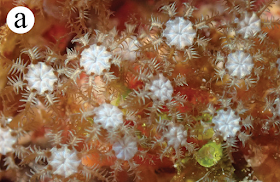Octocorals are colonial Corals, Anthozoa, lacking the extensive mineralised skeletons of Stony Corals. Each polyp of the colony has only eight tentacles, giving the group its name, though these often have numerous side branches, giving them a feathery appearance. Gorgonians are a group of Octocaorals that tend to form fan shaped colonies in shallow environments with strong currents. The Stolonifera is a group within the Octocorallia comprising Corals with polyps which are not set within a common coenenchymal tissue, but rather arise from a branching, ribbon-like stolon which spreads over the substrate, typically another Coral or Sponge. These Corals are less well studied than other Soft Corals, and relationships within the group are poorly understood.
In a paper published in the journal ZooKeys on 15 October 2018, Yee Wah Lau of the Molecular Invertebrate Systematics and Ecology Laboratory at the University of the Ryukyus, Frank Stokvis and Leendert van Ofwegen of the Naturalis Biodiversity Center, and James Davis Reimer, also of the the Molecular Invertebrate Systematics and Ecology Laboratory, and of the Tropical Biosphere Research Center at the University of the Ryukyus, describe two new species of Stoloniferous Octocorals from the northwest Pacific Ocean.
The first species is placed in a new genus, named Hana, which means ‘flower’ in Japanese, and given the specific name hanagasa, in reference to a flowered head-dress worn during traditional dances in Okinawa, in both cases this refers to the polyps of the species, which are somewhat floral in appearance. This species typically forms colonies of 50-100 polyps arising from ribbon-like stolons about 0.5 mm in diameter. Each polyp lives within a calyce 2.5-3.0 mm in height, into which they can completely withdraw. The polyps are spaced irregularly on the stolen, with the gap between them ranging from about 0.3 mm to about 2.5 mm. The species was found living on hard Coral rock on the northwest coast of Okinawa Island and southeast coast of Iheya Island, both in the Ryukyu Island chain.
The first species is placed in a new genus, named Hana, which means ‘flower’ in Japanese, and given the specific name hanagasa, in reference to a flowered head-dress worn during traditional dances in Okinawa, in both cases this refers to the polyps of the species, which are somewhat floral in appearance. This species typically forms colonies of 50-100 polyps arising from ribbon-like stolons about 0.5 mm in diameter. Each polyp lives within a calyce 2.5-3.0 mm in height, into which they can completely withdraw. The polyps are spaced irregularly on the stolen, with the gap between them ranging from about 0.3 mm to about 2.5 mm. The species was found living on hard Coral rock on the northwest coast of Okinawa Island and southeast coast of Iheya Island, both in the Ryukyu Island chain.
Hana hanagasa from Okinawa. Lau et al. (2018).
The second species is also placed in the genus Hana, and given the specific name hanataba, meaning a bouquet in Japanese, again in reference to the floral appearance of the polyps. This species typically forms colonies of 30-100 polyps, again rising dwelling within calyxes 2.5-3.0 mm high and arising from a branching stolon 0.5 mm in width. It was found dwelling off the southeast coast of Palau and off the Taiwanese atoll of Dongsha.
Hana hanataba from Ngemelis Island, Palau. Lau et al. (2018).
See also...
Follow Sciency Thoughts on Facebook.







